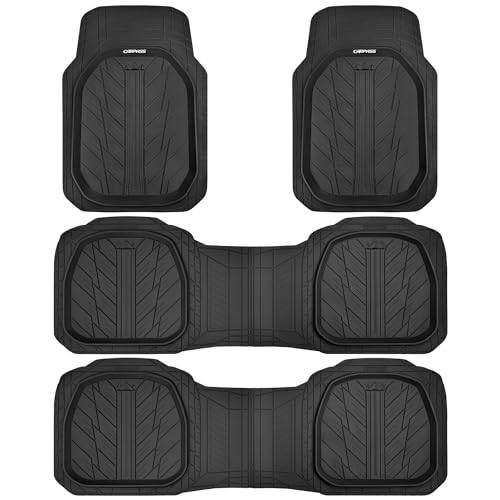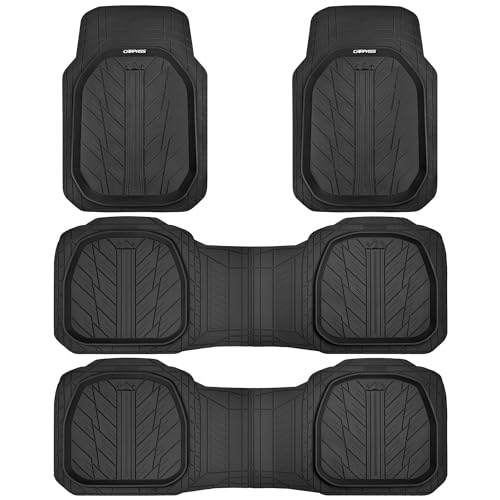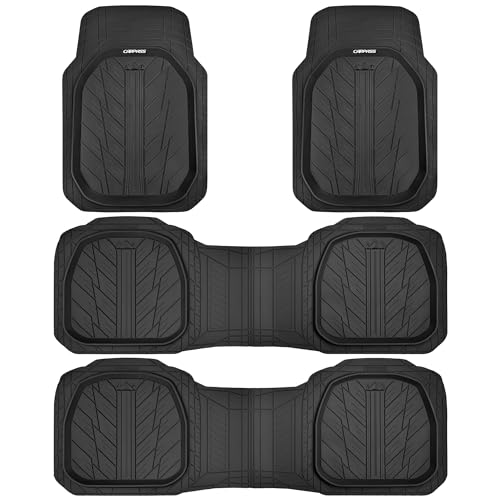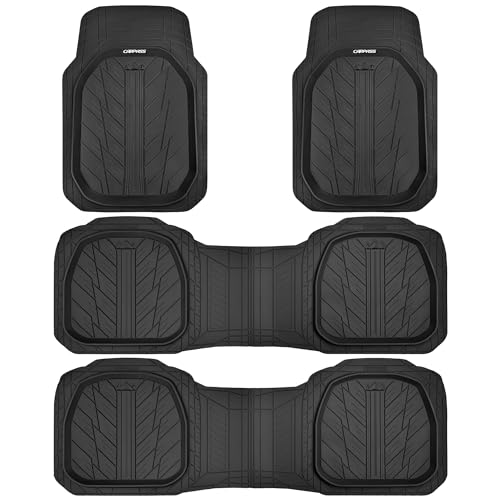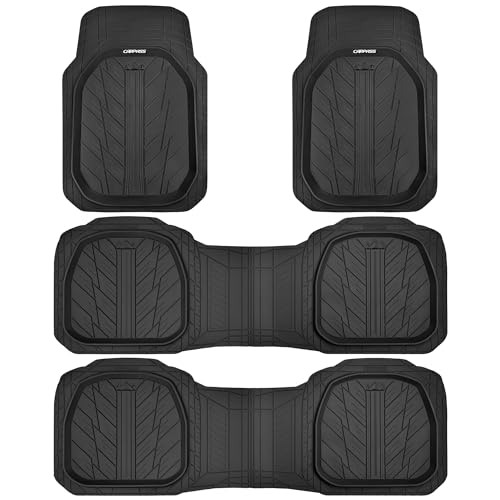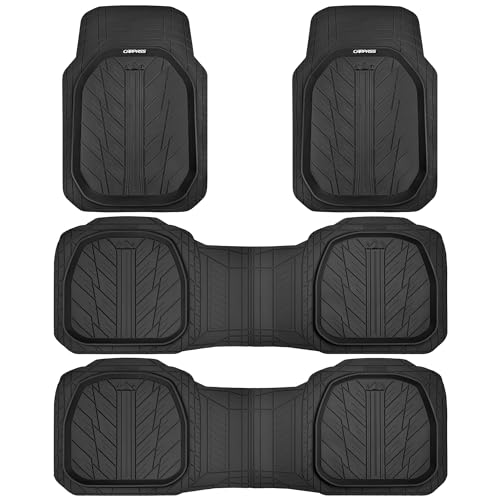In the ever-evolving world of automobiles, SUVs (Sport Utility Vehicles) have emerged as a dominant force. But what exactly is an SUV, and how did these versatile vehicles rise to such prominence? Buckle up, as we delve into the history and definition of SUVs, exploring their transformation from off-road warriors to the popular family cars they are today.
Characteristics of SUVs: Built for Adventure (and Everything In Between)
SUVs stand out from the crowd thanks to a unique blend of features that cater to both adventure and everyday needs. Let’s explore the key characteristics that define an SUV:
Elevated for the Challenge: Ground Clearance
One of the most noticeable characteristics of SUVs is their raised ground clearance. This extra space between the underbody and the ground translates into several advantages. It allows SUVs to navigate rough terrain more easily, tackle obstacles like curbs and potholes with confidence, and offer a commanding view of the road.
4WD vs. AWD: Understanding the Grip
SUVs are often associated with four-wheel drive (4WD), a system that provides power to all four wheels simultaneously. This enhances traction in challenging off-road conditions like snow, mud, or sand. However, many modern SUVs also offer all-wheel drive (AWD). While similar to 4WD, AWD typically prioritizes on-road performance by automatically adjusting power distribution between the axles for better handling and stability in all weather conditions.
Spacious Interiors and Cargo Chameleons
When it comes to passenger and cargo space, SUVs typically reign supreme compared to sedans. Their larger size translates into spacious interiors that comfortably seat five or even seven passengers, depending on the model. Additionally, the ample cargo space with configurable seating allows for easy transportation of gear, groceries, luggage, or even sporting equipment, making them ideal for active families or those who frequently require extra hauling capacity.
Rugged Looks and Hauling Muscle
The design of SUVs often reflects their adventurous spirit. They typically boast a rugged design with bold lines, higher ride height, and protective elements like skid plates. This not only enhances their off-road capability but also contributes to their overall utility. Additionally, compared to sedans, SUVs generally have a higher towing capacity, making them suitable for hauling trailers, boats, or even small campers.
Types of SUVs: Finding the Perfect Fit for Your Needs
The world of SUVs offers a diverse range of options to cater to various needs and lifestyles. Let’s explore the different types of SUVs and their defining characteristics:
Full-Size SUVs: Go Big or Go Home
Sitting at the top of the SUV hierarchy are full-size SUVs. These behemoths, like the Chevrolet Suburban or Ford Expedition, boast body-on-frame construction, similar to pickup trucks. This translates into a robust build, exceptional towing capacity, and maximum passenger and cargo space, making them ideal for large families or those who frequently require maximum hauling muscle. However, their size can come with drawbacks like lower fuel efficiency and maneuverability challenges in tight spaces.
Mid-Size SUVs: The Golden Mean
Offering a balance between size and practicality, mid-size SUVs are popular choices for families. Examples include the Toyota Highlander and Honda Pilot. They typically utilize unibody construction, which combines the frame and body for a lighter weight and more car-like ride. Mid-size SUVs offer comfortable seating for five to seven passengers, ample cargo space, and decent towing capacity, making them versatile for everyday use and occasional adventures.
Compact SUVs: City Slickers with Bite
For those seeking a blend of SUV functionality with a more manageable size, compact SUVs like the Honda CR-V or Jeep Wrangler are perfect options. They offer comfortable seating for five, good cargo space, and often come with AWD options for increased capability. Their smaller size makes them ideal for navigating city streets and tight parking spots while still providing enough space for everyday adventures.
Subcompact SUVs: Efficiency Meets Utility
The newest members of the SUV family are subcompact SUVs. Think Hyundai Kona or Toyota C-HR. These pint-sized powerhouses prioritize fuel efficiency and maneuverability, making them ideal for urban environments and budget-conscious buyers. While their passenger and cargo space is more limited compared to larger SUVs, they still offer enough utility for everyday needs and provide a higher driving position compared to sedans.
Pros and Cons of SUVs: Weighing the Advantages and Disadvantages
SUVs have become a popular choice for many drivers, but like any vehicle, they come with their own set of advantages and disadvantages. Here’s a breakdown of the key pros and cons to help you decide if an SUV is the right fit for you:
Pros:
- Safety First: Due to their larger size and higher ground clearance, SUVs offer a safety advantage. They provide better visibility for the driver, and in the event of a collision, the higher seating position can offer more protection for occupants.
- Comfort Cruising: SUVs generally boast comfortable interiors with ample legroom and headroom for passengers. The higher seating position can also be more comfortable for long journeys, reducing fatigue.
- Capability Counts: Many SUVs, particularly those with AWD or 4WD systems, offer impressive capability for handling off-road conditions and various terrains. Whether you’re tackling snowy roads, dirt trails, or simply navigating a bumpy driveway, SUVs provide the confidence to go further.
- Versatility is King: The spacious interior and cargo space of SUVs make them incredibly versatile. They can easily accommodate families, gear for outdoor adventures, or even large shopping hauls, making them ideal for active lifestyles.
Cons:
- Fuel Efficiency Foe: The larger size and powerful engines of SUVs often translate to lower fuel efficiency compared to sedans. This can be a significant factor for budget-conscious drivers, especially with rising gas prices.
- Handling Hiccups: Due to their higher center of gravity, SUVs may not handle corners or tight spaces as well as sedans. This can be a consideration for those who prioritize a more sporty driving experience.
- Maneuverability Matters: The larger size of SUVs can also present challenges in terms of maneuverability. Parking in tight spaces or navigating narrow roads might require a bit more skill and planning compared to a smaller car.
- Cost Considerations: From the initial purchase price to maintenance costs, SUVs generally come with a higher overall cost compared to sedans. This includes factors like fuel, insurance, and potential repairs due to their complex drivetrains.
Popular SUV Models: Cruising Through the Top Choices
Having explored the different types and considerations, you might be wondering which SUV models reign supreme in the market. Here’s a glimpse at some of the most popular SUVs across various sizes:
Compact SUV Champion: Toyota RAV4
The Toyota RAV4 has consistently topped the charts for a reason. This compact SUV offers a winning combination of fuel efficiency, reliability, safety features, and a comfortable ride. It’s perfect for everyday driving and small families.
Mid-Size Marvel: Honda Pilot
Known for its spacious interior, comfortable seating for eight, and impressive cargo space, the Honda Pilot is a family-favorite mid-size SUV. It boasts strong safety ratings and a smooth ride, making it a top choice for those seeking versatility and comfort.
Full-Size Force: Jeep Grand Cherokee
The Jeep Grand Cherokee offers a blend of rugged capability and luxurious comfort. This full-size SUV tackles off-road challenges with ease thanks to its available 4WD system and impressive ground clearance. Yet, it doesn’t compromise on comfort, featuring a refined interior and a plethora of amenities.
Subcompact Spotlight: Hyundai Kona
For those seeking an efficient and stylish city runner, the Hyundai Kona stands out. This subcompact SUV boasts impressive fuel economy, a tech-laden interior, and a fun driving experience. Its manageable size makes it perfect for navigating urban environments.
Electric Extraordinaire: Tesla Model X
The Tesla Model X breaks the mold, offering a luxurious and futuristic electric SUV experience. With its innovative falcon-wing doors, spacious interior, and exceptional performance, the Model X appeals to environmentally conscious drivers seeking a statement-making SUV.
SUVs vs. Other Vehicle Types: Picking the Perfect Ride
While SUVs have become a dominant force, they aren’t the only option on the road. Here’s a quick comparison of SUVs with other popular vehicle types to help you choose the right fit:
SUVs vs. Sedans:
- SUVs: Offer more space, cargo capacity, higher driving position, and potentially better safety ratings. May have lower fuel efficiency and handling.
- Sedans: Typically more fuel-efficient and offer a sportier driving experience due to their lower center of gravity. Less cargo space and passenger capacity compared to most SUVs.
SUVs vs. Wagons:
- SUVs: Generally offer more ground clearance, a more rugged design, and potentially better off-road capability. Wagons might provide a more car-like driving experience.
- Wagons: Often prioritize fuel efficiency and handling due to their lower profile. They can offer surprising cargo space with the rear seats folded and a lower entry point compared to SUVs.
SUVs vs. Pickup Trucks:
- SUVs: Offer a more comfortable ride, enclosed cargo space, and often come with features like passenger seating for more than five. May have lower towing capacity.
- Pickup Trucks: Designed for maximum towing and hauling capability with an open truck bed. Can be less comfortable for passengers on long journeys due to a stiffer ride.
Choosing the Right SUV: Tailoring Your Ride to Your Needs
With a vast array of SUVs available, selecting the perfect one requires careful consideration. Here’s a roadmap to guide you through the process:
1. Define Your Needs:
The first step is to identify your priorities. Ask yourself:
- Seating Capacity: How many people will you be regularly transporting?
- Cargo Space: Do you require ample space for groceries, sports equipment, or frequent trips?
- Off-Road Capability: Will you be venturing off the beaten path, or is on-road comfort your main concern?
2. Research and Compare:
Once you have a clearer picture of your needs, delve into research. Utilize online resources, car review websites, and consumer reports to compare different SUV models within your preferred size category (full-size, mid-size, compact, subcompact). Pay attention to factors like:
- Fuel Efficiency: Consider your budget and driving habits.
- Safety Ratings: Prioritize features like automatic emergency braking and lane departure warning.
- Features and Technology: Evaluate the infotainment system, driver assistance features, and comfort amenities.
- Cargo Space Flexibility: Look for features like folding seats and adjustable cargo compartments.
- Reliability Ratings: Research the model’s reputation for reliability and maintenance costs.
3. Test Drive and Trust Your Instincts:
The research phase is crucial, but there’s no substitute for a test drive. Schedule test drives with a shortlist of SUVs that meet your criteria. Get behind the wheel, experience the ride quality, evaluate passenger and cargo space, and assess how comfortable the controls are.
During the test drive, pay attention to:
- Visibility: Can you see clearly from the driver’s seat?
- Handling: How does the SUV handle corners and city streets?
- Comfort: Are the seats comfortable for long journeys?
- Technology: Is the infotainment system user-friendly?
Ultimately, the best SUV for you is the one that perfectly aligns with your needs and driving style. By following these steps and trusting your instincts during the test drive, you’ll be well on your way to finding the perfect SUV companion for your adventures.
The Future of SUVs: Gearing Up for Innovation
The world of SUVs is constantly evolving, and the future holds exciting possibilities in terms of design and technology. Here’s a glimpse into what we can expect:
- Electric Revolution: The rise of electric vehicles (EVs) is undoubtedly shaping the future of SUVs. We can expect a surge in electric SUVs offering impressive range, exceptional performance, and a more sustainable driving experience. From the luxurious Tesla Model X to the upcoming electric versions of popular models like the Ford Mustang Mach-E, the future of SUVs will be increasingly electric.
- Self-Driving Potential: The development of autonomous driving technology has the potential to transform the SUV experience entirely. Imagine cruising down the highway in a self-driving SUV, allowing you to relax, work, or simply enjoy the scenery. While fully autonomous vehicles might still be some time away, expect to see advancements in driver-assistance features like adaptive cruise control and lane-centering assist, paving the way for a more autonomous future.
- Connected Convenience: Technology will continue to play a major role in SUVs. Expect even greater integration of connectivity features like Apple CarPlay and Android Auto. Advanced infotainment systems with larger touchscreens, voice-activated commands, and Wi-Fi hotspots will become commonplace, transforming the SUV into a mobile entertainment hub.
- Focus on Efficiency: As fuel efficiency remains a key concern, advancements in engine technology and lightweight materials will lead to the development of more fuel-efficient SUVs. Hybrid SUVs will likely become even more popular, offering a balance between power and efficiency. Additionally, aerodynamic design improvements will further contribute to better fuel economy.
- Rugged Refinement: The core strengths of SUVs – capability and versatility – will not be forgotten. Expect to see SUVs that maintain their off-road prowess while incorporating more refined design elements and luxurious features. Think rugged yet luxurious interiors, advanced all-wheel-drive systems, and innovative features that enhance off-road capability without compromising comfort.
The future of SUVs is bright, with innovation geared towards sustainability, convenience, and a blend of rugged capability with modern technology. Whether you’re an adventure seeker or a family-focused driver, the perfect SUV for your needs is likely just around the corner.
People Also Ask (PAA) Section: Unveiling the SUV Mystery
Q: Are SUVs good for gas mileage?
A: Traditionally, SUVs haven’t been known for stellar gas mileage due to their larger size and powerful engines. However, there are exceptions. Compact SUVs and subcompact SUVs offer significantly better fuel efficiency compared to larger models. Additionally, the rise of hybrid and electric SUVs like the Toyota RAV4 Hybrid or Tesla Model X provides more eco-friendly options with impressive fuel economy.
Q: Are SUVs safe?
A: In general, SUVs are considered safe vehicles. Their larger size and higher ground clearance offer a safety advantage. They provide better visibility for the driver and improved protection for occupants in the event of a collision. Additionally, many SUVs come equipped with advanced safety features like automatic emergency braking and lane departure warning, further enhancing their safety credentials.
Q: What’s the difference between an SUV and a crossover?
A: The terms SUV and crossover are often used interchangeably, but there are subtle differences. Traditional SUVs typically utilize a body-on-frame construction, similar to pickup trucks, making them more rugged and better suited for off-roading. Crossovers, on the other hand, generally have a unibody construction, where the frame and body are integrated. This results in a lighter weight, more car-like handling, and often better fuel efficiency compared to SUVs. However, crossovers may not offer the same level of off-road capability.
Q: Do I need a four-wheel drive SUV?
A: Whether you need a four-wheel drive (4WD) SUV depends on your driving habits and environment. If you primarily navigate city streets and well-maintained roads, a two-wheel drive (2WD) SUV with good all-weather tires might suffice. However, if you frequently encounter snow, mud, sand, or off-road conditions, a 4WD SUV provides superior traction and capability. Additionally, many modern SUVs offer all-wheel drive (AWD) systems that automatically adjust power distribution for improved handling and stability in all weather conditions, being a good compromise for those who may occasionally encounter challenging terrain.
Conclusion:
SUVs have emerged as a dominant force in the automotive landscape, and for good reason. They offer a compelling blend of features that cater to a wide range of needs and lifestyles.
Recap of Key SUV Benefits:
- Spacious Interiors and Ample Cargo: SUVs excel in providing comfortable seating for passengers and ample cargo space, making them ideal for families and those with active lifestyles.
- Elevated Capability: With higher ground clearance and available features like 4WD or AWD, SUVs offer greater capability to handle rough roads, off-road adventures, and various weather conditions.
- Safety First: The larger size and higher seating position of SUVs contribute to a perceived safety advantage, offering better visibility and potentially improved protection in collisions.
- Versatility Reigns Supreme: Whether you’re tackling a mountain trail, hauling groceries, or embarking on a road trip with the family, SUVs offer the versatility to adapt to your needs.
Are SUVs Right for You?
The answer depends on your individual needs and priorities. Consider your lifestyle, family size, typical driving situations, and budget. If you require ample space, prioritize comfort and capability, and appreciate a higher driving position, then an SUV might be the perfect fit. However, if fuel efficiency and a sportier driving experience are your top concerns, a sedan or wagon might be a better choice.
The Future is SUV-picious
With continuous advancements in technology, design, and efficiency, the future of SUVs promises exciting developments. From electric and self-driving options to a focus on sustainability and connected features, SUVs are poised to remain a popular choice for drivers seeking a blend of functionality, comfort, and innovation.


